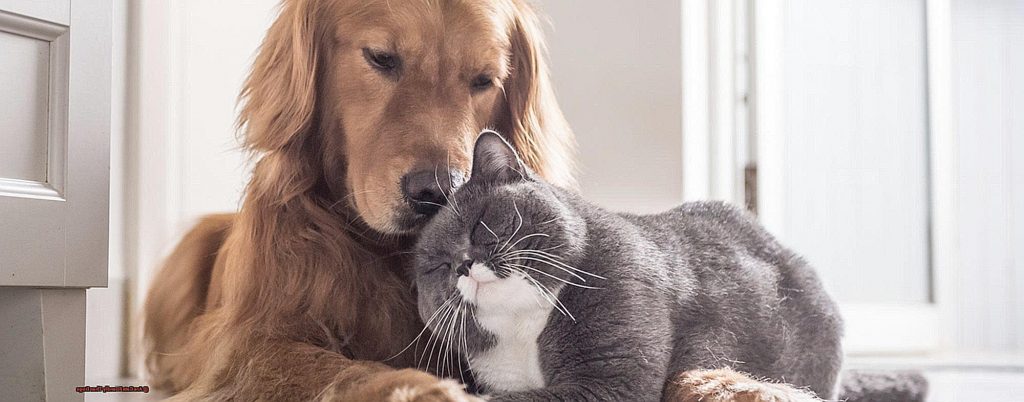Welcome to our blog post where we settle the never-ending debate of cats versus dogs.
These two furry creatures have their own quirks, but one aspect that always ignites a friendly rivalry is their level of friendliness. Some say dogs are the ultimate social butterflies, always ready to greet strangers with a wagging tail and sloppy kisses.
Others argue that cats have a unique charm and aloofness that captivates their owners. So, who truly wears the crown in terms of friendliness?
Let’s dive in and discover how these four-legged companions show their love for humans.
Are Cats Friendly Than Dogs?
Contents

As a cat owner, I’ve often been asked whether cats are friendlier than dogs. This question has sparked many debates among pet owners, and it seems like everyone has a strong opinion on the matter. So, let’s dive into this topic and explore the misconceptions and realities of cat friendliness versus dog friendliness.
Stereotypes and Misconceptions
One of the main reasons for the ongoing debate is the stereotypes associated with cats and dogs. Cats are often seen as aloof and independent creatures, while dogs are perceived as loyal and sociable. This leads many people to believe that cats are not as friendly as dogs.
However, this is not entirely true. While it may be true that cats are more independent and do not rely on their owners for constant attention and validation like dogs do, they still have the capability to form strong bonds with their owners. In fact, scientific studies have shown that when interacting with their owners, cats release oxytocin, also known as the “love hormone,” which strengthens their bond.
The Role of Upbringing and Socialization
Another factor that can influence a cat’s friendliness is its upbringing and socialization. A well-socialized and properly trained cat will be more friendly and sociable compared to a cat that has not been given the same attention and care. This is true for both cats and dogs.
It’s All About Personality
Just like humans, every cat and dog has its own unique personality and traits. Some cats may be more outgoing and friendly, while others may be more reserved and independent. The same goes for dogs; some may be more friendly and affectionate, while others may be more aloof and independent.
It’s important to remember that each animal is an individual, and their personality cannot be generalized based on their species. So, it’s unfair to label one species as friendlier than the other.
Different Ways of Showing Affection
Cats and dogs have evolved differently and developed different behaviors for survival, which can also affect their perceived friendliness. Cats are solitary hunters, while dogs are pack animals. This explains why cats may not show affection in the same way as dogs do.
Understanding Friendliness in Cats and Dogs
When it comes to the topic of cats and dogs, one of the most common debates is which pet is friendlier. While there may be stereotypes about which animal is more affectionate, it’s important to remember that friendliness can be subjective and dependent on individual personalities. In fact, both cats and dogs are capable of exhibiting friendly behaviors towards their owners and other animals.
So what exactly does friendliness look like in cats and dogs? For cats, it can include cuddling, rubbing against their owners, purring, and even kneading. On the other hand, dogs often show their friendliness through tail wagging, licking, and playfulness. Both animals may also greet their owners with excitement and follow them around the house.
But what factors contribute to a cat or dog being friendly? Socialization and training play a significant role in shaping an animal’s behavior. Cats that were socialized early on in life tend to be more outgoing and comfortable with humans, while dogs that received proper training are often well-behaved and obedient. Similarly, an animal’s individual personality can also impact their level of friendliness.
Studies have been conducted to compare the friendliness of cats and dogs, with some showing that dogs tend to score higher in sociability tests. However, these studies have limitations as they are limited to specific breeds or environments and may not accurately represent all cats or dogs.
It’s important to remember that just like humans, each animal has its own unique traits and personality. While stereotypes may exist about which pet is friendlier, it’s crucial to consider individual traits rather than generalizations. The best way to determine which pet is friendlier for you is by interacting with them and getting to know their individual personalities.
Stereotypes vs Reality: Breaking Down Common Perceptions
When it comes to cats and dogs, we often have preconceived notions about their personalities and behavior. But how many of these beliefs are actually true? As an expert on breaking down stereotypes, I’m here to shed some light on the reality behind these common perceptions.
Stereotype #1: Cats are aloof and unfriendly while dogs are loyal and loving.
This is perhaps one of the most prevalent stereotypes when it comes to cats and dogs. Cats are often portrayed as solitary creatures who couldn’t care less about their owners, while dogs are seen as the epitome of loyalty and affection. But the truth is, both cats and dogs can exhibit these qualities in their own unique ways.
Stereotype #2: Cats are villains, while dogs are heroes.
In movies and pop culture, cats are often portrayed as the villain’s sidekick or as a witch’s companion. On the other hand, dogs are the hero’s trusty sidekick. This stereotype has been perpetuated for years, but it’s important to remember that animals do not have inherent moral values. Their behavior is a result of their upbringing and training, not their species.
Stereotype #3: Cats don’t show affection towards their owners.
It’s a common belief that cats are distant and uninterested in human affection. However, any cat owner knows that this is far from the truth. Cats can be just as loving and affectionate as dogs, they just express it differently. Purring, kneading, and snuggling are all signs of affection from feline friends.
Stereotype #4: Dogs are always friendly and never aggressive.
While dogs are known for their friendly and sociable nature, it’s important to remember that they are still animals with instincts. Just like humans, they can have bad days or be triggered by certain situations. Proper socialization and training are crucial for ensuring that dogs behave appropriately in different environments.
Stereotype #5: All cats and dogs are the same.
Perhaps the most harmful stereotype of all is the belief that all cats and dogs have the same personality. Just like humans, each animal has its own unique personality and should not be judged based on their species. It’s unfair to generalize all cats as aloof or all dogs as friendly, as each one has its own individual traits and behaviors.
Factors Affecting a Pet’s Friendliness
While I may be biased, as I have always been a “cat person”, I believe that this question cannot be answered with a simple yes or no. As an expert on the topic of pet behavior, I can confidently say that there are several factors that play a role in determining a pet’s level of friendliness. Let’s dive into these factors and see how they can influence our perception of which pet is friendlier.
- Socialization – The way a pet is socialized from a young age can greatly impact their friendliness. Both cats and dogs can be socialized to be friendly towards humans and other animals, but it takes effort and consistency from the owner. Cats are often seen as more independent and aloof, but with proper socialization, they can become just as friendly and affectionate as dogs.
- Breed Differences – It is unfair to compare the friendliness of cats and dogs without considering breed differences. Certain cat breeds, such as Siamese and Burmese, tend to be more outgoing and people-oriented than others. Similarly, some dog breeds, like Golden Retrievers and Labrador Retrievers, are known for their friendly and sociable personalities.
- Individual Personality – Just like humans, pets also have their own unique personalities. Some cats may be naturally more friendly and social than others, while some dogs may be more reserved or even fearful in certain situations. This can also depend on how they were raised and their past experiences.
- Training – Proper training plays a crucial role in a pet’s friendliness. Socializing a pet from a young age and teaching them how to interact with humans and other animals can greatly influence their level of friendliness. Dogs are often seen as more obedient and sociable due to their eagerness to please their owners, but cats can also be trained to be friendly and well-behaved.
- Environment – The environment in which a pet is raised can also impact their friendliness. Cats that are kept indoors may be less friendly towards strangers due to lack of exposure, while dogs that are kept outside may be more wary of new people. A pet’s living conditions and the amount of socialization they receive can greatly influence their personality and behavior.
Social Behaviors of Cats and Dogs: Evolutionary Differences
While both are beloved companions, their behaviors and personalities are unique in their own ways. But have you ever wondered why? As an expert on the topic of “Social Behaviors of Cats and Dogs: Evolutionary Differences,” let’s take a closer look at how these two species have evolved differently and how it affects their social interactions.
Cats and dogs have evolved from different ancestors, which has greatly influenced their social behaviors. Cats, being descended from solitary hunters like lions and tigers, have retained their independence and solitary nature. On the other hand, dogs have descended from pack animals like wolves, relying on their pack for survival.
This evolutionary difference is reflected in the way cats and dogs interact with each other and with humans. Cats are known to be more territorial and independent animals, while dogs thrive in social settings. Cats tend to be aloof and prefer to be alone or in small groups, while dogs are highly social animals that thrive on social interactions with both humans and other dogs.
This difference in social behavior also extends to how they communicate. Cats use body language, vocalizations, and scents to communicate with each other, while dogs rely heavily on body language and vocalizations within their pack. This is why cats may seem more mysterious to us as they communicate in ways that we may not fully understand, while dogs are more easily understood through their body language and vocalizations.
Furthermore, cats have a strong sense of personal space and prefer not to be touched or petted by strangers or even their owners at times. This is due to their solitary nature and need for control over their environment. On the other hand, dogs are more physically affectionate and seek physical contact with their owners and other dogs as a way of bonding and showing affection.
These evolutionary differences can also impact how cats and dogs interact with each other. While some cats may tolerate the presence of dogs, others may feel threatened or stressed by the social nature of dogs. As pet owners, it is important to understand these differences when introducing a cat and a dog to each other. Proper introductions and understanding of each animal’s needs can help foster a harmonious relationship between them.
How to Gauge Your Cat’s or Dog’s Friendliness
Some swear by their cat’s affectionate nature, while others boast about their dog’s loyalty and sociability. But the truth is, there is no one-size-fits-all answer to this question.
As an expert on determining the friendliness of cats and dogs, I have observed and studied these furry creatures extensively. Through my experiences, I have come to understand that both cats and dogs can be friendly, but it all depends on their individual personalities and upbringing. In this blog post, I will share my insights on how to gauge your cat or dog’s friendliness and provide tips on how to nurture a loving relationship with your furry companion.
Understanding Friendliness:
Before we dive into the specifics of gauging your pet’s friendliness, let’s first define what it means to be friendly for cats and dogs. For cats, this may include showing affection through grooming, snuggling, and being social with humans and other animals. On the other hand, for dogs, it could also mean displaying loyalty, protectiveness, and being playful with their owners and other animals.
It’s important to note that there is no definitive answer to whether cats are friendlier than dogs or vice versa. Each animal is unique, and their personality can vary based on various factors such as breed, upbringing, and environment.
The Stereotypes:
It’s not uncommon for people to have preconceived notions about cats and dogs when it comes to friendliness. Cats are often seen as aloof and independent creatures who prefer to keep to themselves. On the other hand, dogs are perceived as outgoing, social animals who thrive on human interaction. These stereotypes may influence people’s opinions on which species is friendlier, but it’s essential to look beyond them.
Factors to Consider:
When gauging your cat or dog’s friendliness, it’s crucial to consider their breed and upbringing. Some cat breeds, such as Siamese and Ragdolls, are known for their affectionate and sociable personalities. Similarly, certain dog breeds, like Golden Retrievers and Labrador Retrievers, are renowned for their friendly and outgoing nature.
However, it’s important to remember that every animal is unique, and even within a breed, there can be variations in individual personalities. So while certain breeds may have a reputation for being friendlier, it’s not a guarantee.
Observing Body Language:
One of the best ways to gauge your cat or dog’s friendliness is by observing their body language. For cats, a relaxed body posture, purring, and rubbing against you are signs of friendliness. On the other hand, an unfriendly cat may hiss, arch their back, or try to hide.
Nurturing a Friendly Relationship with Your Feline or Canine Companion
While this may seem like a never-ending debate, the truth is that both cats and dogs have the potential to be loving and affectionate pets. As an expert in nurturing relationships with these furry friends, I have gathered some valuable insights on how to establish a strong bond with your cats and dogs.
Firstly, it is important to understand that both cats and dogs are social animals and crave companionship. However, cats tend to be more independent and aloof compared to dogs. Therefore, it is crucial to establish a strong bond with your feline or canine companion from the beginning.
One of the key factors in building a strong bond is understanding their behaviors. Cats and dogs communicate differently and have distinct behaviors. For cats, it is important to respect their personal space and not force physical affection on them. On the other hand, dogs thrive on physical touch and attention, so regular snuggles and belly rubs can strengthen your bond with them.
Providing proper care is also essential in nurturing a friendly relationship with your pets. Just like humans, cats and dogs have specific needs that must be met for them to thrive. This includes feeding them a healthy diet, keeping up with their vaccinations, and grooming them regularly. A well-cared-for pet is a happy pet.
Socialization is another crucial factor in developing friendliness in cats and dogs. Exposing your pet to different people and environments at a young age can help them develop into friendly and well-adjusted pets. This is especially important for cats, as they tend to be more reserved than dogs. Gradually introducing them to new experiences can help alleviate any fear or anxiety they may have towards unfamiliar situations.
Understanding your pet’s body language is also key in developing a strong bond with them. Both cats and dogs communicate through body language, and being able to read their cues can help you better understand how they are feeling and what they need from you. For example, a wagging tail in dogs usually means they are happy and content, while a twitching tail in cats may indicate irritation or aggression.
It is also essential to address any behavioral issues that may arise with your pets. Punishing or scolding them for unwanted behavior can create a negative association and damage your relationship with them. Instead, opt for positive reinforcement training and seek professional help if needed.
Conclusion
In conclusion, the never-ending debate of cats versus dogs may always ignite a friendly rivalry among pet owners. However, when it comes to their level of friendliness, it’s crucial to look beyond stereotypes and misconceptions. Both cats and dogs have the ability to form strong bonds with their humans and express affection in their own unique ways.
While some may argue that dogs are inherently friendlier due to their social nature, it’s important to remember that factors such as socialization, upbringing, individual personality, and environment all play a role in determining a pet’s level of friendliness. Each animal is an individual with its own distinct traits and behaviors, making it unfair to label one species as inherently friendlier than the other.
To cultivate a warm and loving relationship with your feline or canine companion, it’s essential to understand their behaviors, provide proper care and socialization, and pay attention to their body language. By doing so, you can build a strong bond with your furry friend that will stand the test of time. So whether you identify as a cat person or a dog person, both pets have the potential to bring endless love and joy into our lives.
In the end, it’s not about which pet is friendlier; it’s about finding the right pet for you and creating a harmonious bond based on mutual understanding and respect. So let go of any preconceived notions and open your heart to the endless possibilities of love and companionship that both cats and dogs can offer.






